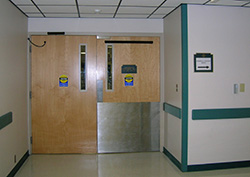Coordinator, Health Sciences, Surgical Services
850.873.3551
bpage2@gulfcoast.edu
The Surgical Suite
 The Surgical Suite can be found in hospitals, outpatient surgery centers, physician
offices, or clinics. The surgical suite is located in a restricted traffic area of
the facility to limit the microbial contamination of the air, floors, and unit. A
prime concern is infection control and the prevention of surgical related complications.
As we enter the area, hats are worn to limit hair contaminants. Clothing worn is
selected with the intention of limiting the number of microbes introduced into the
area.
The Surgical Suite can be found in hospitals, outpatient surgery centers, physician
offices, or clinics. The surgical suite is located in a restricted traffic area of
the facility to limit the microbial contamination of the air, floors, and unit. A
prime concern is infection control and the prevention of surgical related complications.
As we enter the area, hats are worn to limit hair contaminants. Clothing worn is
selected with the intention of limiting the number of microbes introduced into the
area.
 As we move forward into the next century, we base our practices on research and statistics
to remove old practices that have no value, maintain practices that have a proven
value, or improve practices to increase their value.
As we move forward into the next century, we base our practices on research and statistics
to remove old practices that have no value, maintain practices that have a proven
value, or improve practices to increase their value.
The operating schedule assigns a team including the surgeon and patient to a specific operating room. Surgeries in that room for the day may be grouped by specialty such as open heart or the type of surgeon such as a general surgeon.
The team begins their day with the case schedule, but it can change with a phone call about the motor vehicle accident or a gunshot wound downtown. Flexibility is a must, but excitement and satisfaction can be the reward as you respond quickly to the challenge and send a critical patient to the intensive care unit and eventually home.
 Blood contamination and "the sight of blood" is another area of concern for new people
to the operating room. We employ all techniques to prevent hazardous exposure to
both the patient and surgical team. Each person who enters the sterile field scrubs
their hands with an antimicrobial and puts on a sterile gown and gloves. Meticulous
hemostasis is employed to limit blood loss for the patient. Blood loss is actually
minimal for a large number of cases. Masks, goggles, gowns, and gloves are worn as
protective equipment to prevent exposure.
Blood contamination and "the sight of blood" is another area of concern for new people
to the operating room. We employ all techniques to prevent hazardous exposure to
both the patient and surgical team. Each person who enters the sterile field scrubs
their hands with an antimicrobial and puts on a sterile gown and gloves. Meticulous
hemostasis is employed to limit blood loss for the patient. Blood loss is actually
minimal for a large number of cases. Masks, goggles, gowns, and gloves are worn as
protective equipment to prevent exposure.
Surgical techniques such as no pass zones limit hazards from sharp injuries. The team member must be organized with a satisfactory level of core knowledge regarding anatomy and physiology, microbiology, instrumentation, tissue handling techniques, surgical procedures, and wound closure.
 Equipment and monitoring devices are positioned strategically for efficient patient
care. Sterile drapes are used to establish a sterile field that minimizes the microbial
contamination to the absolute irreducible minimum. Movement within the sterile field
is accomplished in a quick and efficient manner.
Equipment and monitoring devices are positioned strategically for efficient patient
care. Sterile drapes are used to establish a sterile field that minimizes the microbial
contamination to the absolute irreducible minimum. Movement within the sterile field
is accomplished in a quick and efficient manner.
The surgical suite has access to sterile supplies, sterilizing devices such as a flash autoclave, fluid and blanket warmers, pharmacy, scrub sinks, and emergency equipment.
Each patient is interviewed and assessed multiple times to ensure the correct patient receives the correct surgical care. Wrong site surgery has received a lot of media attention lately. During the case, just after draping but just prior to incision, the entire team pauses to verify the patient data.
Another area requiring meticulous attention to detail is the counting of sponges, sharps, and instruments used inside the patient during the procedure to prevent foreign body retention.
Anesthesia is responsible for pain control, anesthesia administration, and monitoring/stabilizing the patient's condition during the procedure. The surgeon performs the procedure. Each member has a specific role to play with duties to perform and as a member of the team; each plays an integral part in the process. The surgical suite is very similar to a theater production. We start the procedure by setting the stage ... turning up the lights ... and have plenty of action. If you like drama, you'll love the Surgical Suite.